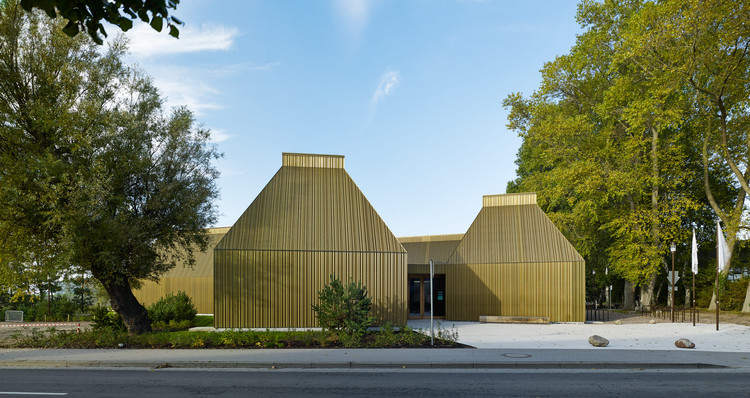
-
Architects: Staab Architekten
- Area: 1400 m²
- Year: 2013
-
Photographs:Stefan Mueller
-
Lead Architects: Volker Staab, Per Pedersen, Anke Hafner

Text description provided by the architects. The artists’ colony in Ahrenshoop is situated on the narrow peninsula between Fischland and Darss. This sparsely populated area on the Baltic Sea, with its dunes and expansive meadows and fields, offers a wealth of landscapes. Ever since the colony was founded in the late nineteenth century, it has attracted artists whose work and homes reflect a deep connection to the landscape and the region’s building tradition. An art museum was to be dedicated to these artists and the history of their colony. To this end a winding plot of land at the entrance to Ahrenshoop was made available along with a small construction budget.

The key to our architectural concept lay in the close relationship of the artists to the landscape. The goal was to create a building that at first glance seemed as if it had always been there, and only on second glance would unfold its autonomy as a cultural institution.



The first problem to solve was one of scale. The museum was significantly larger than the town’s traditional buildings. Only the discovery that the size of the individual exhibition spaces desired corresponded approximately to the size of these buildings led the way to a design solution. Drawing on the notion of a farmstead, the museum would be composed of a group of buildings whose size was based on the measurements of an exhibition room. This approach also freed us from the constraints of the difficult plot. The grouping of the individual “houses” around a center would take precedence, while the L-shaped property outline would recede into the background.

The buildings make no secret of their contemporaryorigin. Although they are based on the shape of the local buildings, they distill their archetype down to a pure, abstract form. The wall and roof surfaces are seamlessly covered with a façade material penetrated only by a few openings.

The correspondence of external and internal form leads to an unexpected spatial experience. A skylight at the apex of the roof enhances the abstract ambience. The uninterrupted wall surfaces create a focused atmosphere in which the small-format exhibits take full effect.
The tension between familiar image and its unfamiliar translation was continued right down to the detailing of the façade. The structure of the vertically profiled brass façade evokes the memory of bundled reeds covering the farmhouse roofs. Even the phenomenon of the darkening of thatched roofs over time is echoed as the brass façade changes from warm gold to matte brown over the years.

These associations are superimposed by the confident, downright radical abstraction of the building envelope. Anchored in local building tradition yet exploring new design paths, the new museum challenges our usual perception and links the traditional image and its transformation.

















